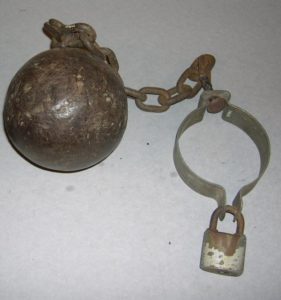During our extended closure we approached UT faculty and staff, and asked them to tell us which object in our collection had the biggest impact on them, their classes, their students, or their research within the museum.
Dr. Katy Chiles, Associate Professor for the Department of English and Vice Chair of Africana Studies, reflects upon a potent object in the collection. The leg shackle has a profound presence and impact. “For my courses on early African-American literature, students are always very moved by seeing (and sometimes feeling the weight of) the ball and chain in the McClung collection. Although the museum doesn’t know if that particular item was used during slavery, it certainly closely resembles many instruments of restraint and torture that were used. After reading powerful narratives by writers such as Frederick Douglass, Harriet Jacobs, and Solomon Northup, students feel that that item gives them an even greater understanding of African-American literature and history.”

Leg Shackle, late 1800s, 1983.14.37.
This shackle was in use from the mid to late 1800s, and is assumed to have been utilized during institutionalized slavery and in forced-labor prison camps. The brace on the shackle is designed to go around an ankle and it is narrow enough to fit a smaller person––perhaps a woman or child. According to our Curator of Academic Programs, Katy Malone, “The lack of information associated with this object mirrors the painful lack of recorded history and resulting disenfranchisement African Americans, who would have had an implement like this used to terrorize, dehumanize, torture, and imprison them.”
Malone continues: “This is a difficult object with which to contend. It is heavy physically and emotionally, which makes it a critical artifact for reflection and for educating students about our collective past. Presenting this object makes the materials the students have read tangible and history real. It gives us the ability to discuss the on-going impact of slavery, trauma, and oppression. We examine the trajectory that bore this object and its usage, and how that trajectory led to the systemic racism that continues to hurt our society and destroy Black lives.”
“When I present this object to a class, I find that the students of UT want to have the dialogue it creates and that they do not want their history hidden. As their museum, they charge us with making space for hard conversations. We have to answer that call.”
To accompany this post we recommend works by Frederick Douglass and Harriet A. Jacobs as additional reading.
- Douglass, Frederick, 1818-1895. Narrative Of the Life of Frederick Douglass, an American Slave. Boston: Bedford/St. Martin’s, 2003 (Reprint).
- Douglass, Frederick, 1818-1895. My Bondage and My Freedom. New York: Penguin Books, 2003 (Reprint).
- Jacobs, Harriet A., 1813-1897. Incidents In the Life of a Slave Girl. New York: Skyhorse, 2015 (Reprint).
Dr. Chiles also adds the following contemporary titles:
- Kendi, Ibram X., How to be an AntiRacist. New York: One World, 2019.
- DiAngelo, Robin J. White Fragility: Why It’s so Hard for White People to Talk About Racism. Boston: Beacon Press, 2018.